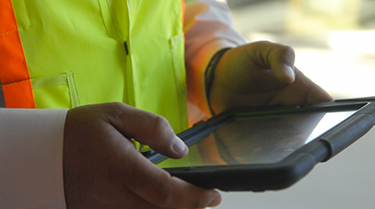|
Subscribe / Renew |
|
|
Contact Us |
|
| ► Subscribe to our Free Weekly Newsletter | |
| home | Welcome, sign in or click here to subscribe. | login |
Construction
| |
 |
January 27, 2014
How tech is changing construction
Wayne Newitts of Dexter+Chaney on Friday made a presentation to AGC members about what his firm calls the Intelligent Jobsite.
Newitts is the marketing director at Dexter+Chaney, a developer of construction software for management and operations. He is an electrical engineer and project manager with 20 years of experience that includes software development for the construction industry.
The DJC asked Newitts about how technology is changing the jobsite.
Wayne Newitts of Dexter+Chaney on Friday made a presentation to AGC members about what his firm calls the Intelligent Jobsite.
Q: What is the Intelligent Jobsite?
A: The Intelligent Jobsite is a place where decisions about construction project work are made with the benefit of information that is both complete and that is put into context. Having complete information means that the jobsite becomes the hub of all project information, not just a source of data for the office or a consumer of reports from the office. Putting this information in context means connecting the many related pieces of data, documentation, and correspondence surrounding project events and milestones so that a useful picture of project status emerges.

Q: How is technology changing jobsite workflow?
A: The confluence of cloud computing and mobile technologies is changing the way information flows between the players involved in construction projects, particularly in the field. Instead of discrete communications and information sharing between individuals, technology is enabling a collaborative approach to work. Entire project teams have access to all the relevant dialogues, transactions and documentation that inform the way work progresses over the life of a project. Cloud computing provides a common platform and point of connection. The explosion of affordable mobile devices — tablets and smart phones — capable of working with data and documents provides the jobsite with the means to make use of the collaborative power of the cloud.
Q: Explain the shift from voice to data on the jobsite.
A: It involves the move from one-on-one communications and working relationships (which voice can serve) to collaborative work where remote teams come together in a more “social” fashion, all contributing simultaneously. This is what data communications enables. You can’t have every person on a project team talking simultaneously to every other, but you can have a central collaborative workspace (i.e., the cloud) where electronic communication and documentation serve as the medium in which everyone can contribute and can be a first-hand party to the contributions of others.
In short, voice works best for one-on-one, and sometimes one-to-many. Data enables many-to-many communication and collaboration, and that is what can make the jobsite more intelligent and efficient.
Q: How do you know which app is best for your company?
A: There has been an explosion in the number of mobile apps, with literally millions available for download and thousands that are relevant for the construction industry. Making deliberate choices about which should be part of your operations is important in today’s environment where nearly all your staff have app-capable mobile devices.
Standardization is perhaps the biggest decision criteria. For apps that serve as simple tools, such as material usage calculators or measurement conversion, it is generally safe to let individuals choose their favorites. For those that impact business or project management decisions, everyone should be using the same software to ensure consistency of data. These include apps for time tracking, inventory and resource scheduling.
Q: Can technology be detrimental to a project?
A: Technology is, of course, a means to an end. When this gets turned around, when the technology horse is put in front of the workflow cart, then odds are the technology will not drive you to the best results for your projects. Technology for technology’s sake not only wastes time and money — it takes focus off of business and operational results.
Even when the work at hand is properly dictating the technology that a company uses, the way a technology is deployed can make or break its effectiveness. New technology implies change, and change requires acceptance, time and training. Deploying jobsite technology by just “tossing it over the wall” at field staff is a recipe for misuse or lack of use. The folks on site need to have a say in technology selection and be given the time and training needed to incorporate new technology into their day-to-day work.
Other Stories:
- AGC elects 2014 officers, board
- Simmons’ focus: transportation and workforce
- AGC honors Pease, Day, McLees, Barrett



